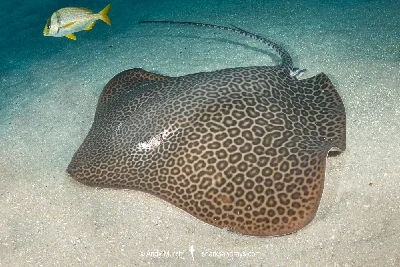Leopard Whipray
Himantura leoparda
The leopard whipray (Himantura leoparda) is a species of stingray in the family Dasyatidae, distributed across the 🇮🇳 Indian and 🌊 Pacific Oceans, particularly from the Andaman Sea to the Coral Triangle. This species typically resides in nearshore environments at depths less than 70 meters (230 feet), favoring soft substrates. The leopard whipray can reach a width of 1.8 meters (5.9 feet) and is characterized by a diamond-shaped pectoral fin disc, a pointed snout, and a notably long, whip-like tail devoid of fin folds. Adult specimens exhibit a distinctive dorsal pattern reminiscent of a leopard, featuring dark brown rings on a yellowish-brown backdrop and a row of heart-shaped dermal denticles along the centerline of the disc. In contrast, newborns and small juveniles display larger, solid dark spots with minimal denticles. This species is frequently targeted by fisheries across its range, primarily for meat.
Historically, the leopard whipray has been confused with the reticulate whipray (H. uarnak) and the honeycomb whipray (H. undulata or its synonym, H. fava) in scientific literature, as all three species share similarities in size, shape, and coloration.
Geographically, the leopard whipray has been recorded in eastern 🇮🇳 India and 🇱🇰 Sri Lanka, throughout Southeast Asia including the 🇵🇭 Philippines, southern 🇯🇵 Japan, 🇹🇼 Taiwan, 🇵🇬 New Guinea, and northern 🇦🇺 Australia, from Coral Bay to the Cape York Peninsula. It is a benthic species, commonly found in shallow, soft-bottomed habitats down to depths of 70 meters (230 feet).
A large species, the leopard whipray can grow up to 1.4 meters (4.6 feet) across and 4.1 meters (13 feet) long. The disc is diamond-shaped, broader than it is long, and features a thickened central area with narrowly rounded to angular outer corners. Its leading edges are sinuous and converge to form a broadly triangular snout with a protruding pointed tip. Juvenile individuals possess a disc nearly equal in length and width. The eyes are small, followed immediately by larger, rectangular spiracles. The species has wide, skirt-shaped nasal flaps with finely fringed posterior edges. The mouth is strongly arched, with shallow grooves at the corners, and contains short papillae and numerous rows of small, conical teeth. The gill slits are S-shaped, the pelvic fins slender, and males exhibit stout claspers.
The tail of the leopard whipray is exceptionally long and thin, measuring 2.5 to 3.8 times the length of the disc, often bearing a serrated stinging spine situated about half a disc width from the tail base, but without fin folds. Adults sport a band of granules extending from the eyes to the tail, with a midline row of heart-shaped denticles on the disc. Juveniles display a distinct color pattern that transitions as they mature, with adults showing a leopard-like pattern of dark rings. The ventral side remains uniformly white. Initial assumptions of alternate color morphs in this species have been corrected through research, which revealed them as separate, reproductively isolated species, H. leoparda and H. tutul.
Due to previous taxonomic confusion with other species, the ecological and biological aspects of the leopard whipray remain inadequately studied. It is presumed to feed on crustaceans and small fish. Like other stingrays, it is aplacental viviparous, relying on histotroph ("uterine milk") to nourish embryos. Newborns measure approximately 20 centimeters (7.9 inches) across and 92 centimeters (36 inches) long, with sexual maturity in males reached between 70 to 80 centimeters (28 to 31 inches) across. Known parasites include the tapeworms Parachristianella indonesiensis and P. baverstocki.
The International Union for Conservation of Nature (IUCN) has classified the leopard whipray as Vulnerable. Particularly in parts of 🇮🇩 Indonesia, the species is subject to intensive fishing for its meat and possibly its skin and cartilage, utilizing methods such as bottom trawls, tangle nets, and longlines. Juveniles constitute a significant portion of the caught population in eastern 🇮🇩 Indonesia.
Comments
Please, sign in to leave comment
No Comments yet
Last Update: May 28, 2025

